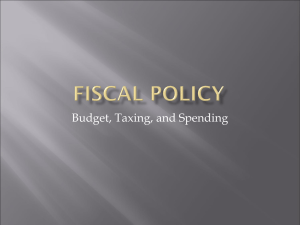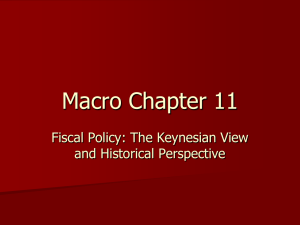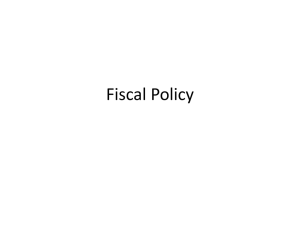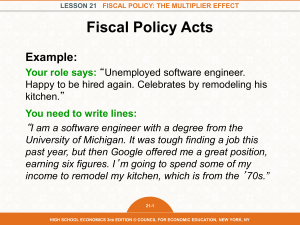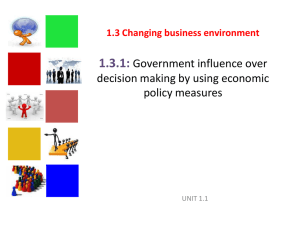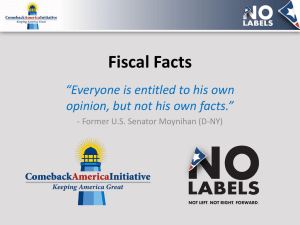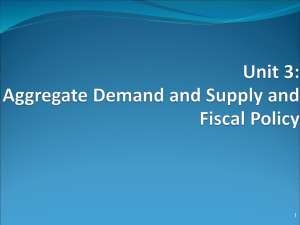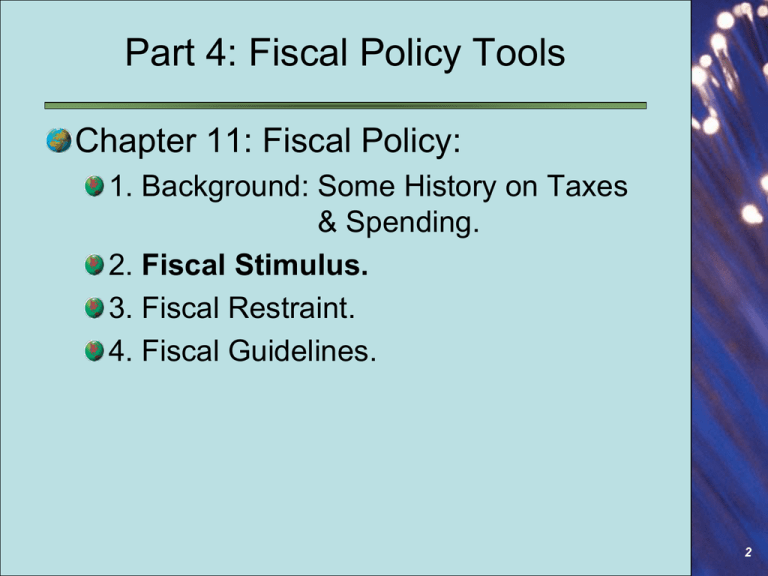
Part 4: Fiscal Policy Tools
Chapter 11: Fiscal Policy:
1. Background: Some History on Taxes
& Spending.
2. Fiscal Stimulus.
3. Fiscal Restraint.
4. Fiscal Guidelines.
2
1. Background:
Taxes & Spending.
(Brief Overview)
3
Taxes and Spending
The federal government:
1902:
employed < than 350,000 people,
Spending = $650 million.
Today,
employs > 4 million people,
Spending = $3 trillion.
5
Government Revenue
Government expansion started with the 16th
Amendment to the U.S. Constitution (1913):
granted the power to tax
incomes.
Today, the federal
government collects nearly
$3 trillion a year in taxes.
All of this government
spending directly affects
aggregate demand.
6
Purchases vs. Transfers
Government purchases:
part of aggregate demand.
Spent on resources to provide services.
Income transfers (“transfer payments”):
payments to individuals for which no current
goods or services are exchanged.
It contributes to consumer income.
Not part of AD until spent by consumers.
7
Fiscal Policy
Fiscal Policy:
The federal government can alter
aggregate demand and macro outcomes
by changing its own level of:
Spending,
Taxing,
Income transfers.
8
Fiscal Policy
DETERMINANTS
Internal market
forces
OUTCOMES
AS
Output
Jobs
Prices
External
shocks
Growth
Policy levers:
Fiscal policy
AD
International
balances
9
2. Fiscal Stimulus.
-The naïve Keynesian model.
-The AD shortfall.
-The multiplier.
-The formula for desired fiscal stimulus.
- Translating fiscal stimulus into spending,
tax, or income transfer changes.
10
Fiscal Stimulus
Keynesian Strategy:
the way out of recession is to get someone
to spend more on goods and services.
It can start with the government.
Fiscal Stimulus:
Tax cuts/spending or
transfer payment increases.
intended to increase AD.
11
Keynesian Strategy
Two strategic policy questions
must be answered:
1. By how much do we want to shift the
AD curve to the right?
2. How to induce the desired shift?
12
Price Level (average price)
The Policy Goal
AS
Full-employment GDP
AD1
a
PE
b
The goal is to
close GDP gaps
GDP Equilibrium
GDP gap
QE = 5.6
6.0 = QF
Real GDP (trillions of dollars per year)
13
The Naive Keynesian Model
The Naive Keynesian Model:
The desired spending (AD) increase =
the GDP gap.
An increase in AD by $400 billion will
achieve full employment.
Price Level
BUT…
AS
Full-employment GDP
…ThisADis only possible if the
a
b
Paggregate supply curve is horizontal.
1
E
GDP Equilibrium
QE = 5.6
GDP gap
6.0 = QF
Real GDP (trillions of dollars per year)
14
Price Level (average price)
Naïve Keynesian Model
AS
AD2
AD1
c
a
PE
b
Recessionary
GDP gap
QE = 5.6
QF = 6.0
Real GDP (trillions of dollars per year)
LO1
15
Price Level (average price)
The AD Shortfall
AS
AD3
AD2
d
AD1
c
a
PE
b
e
Recessionary
GDP gap
AD shortfall
QE = 5.6
QF = 6.0
6.4
Real GDP (trillions of dollars per year)
LO1
17
Price Level (average price)
The AD Shortfall
AD3
AS
d
AD1
a
PE
e
Recessionary
GDP gap
AD shortfall
QE = 5.6
QF = 6.0
6.4
Real GDP (trillions of dollars per year)
LO1
18
The AD Shortfall
The “fiscal target…”
(total new spending needed to reach Qf at equilibrium)
is (=)…
…the “AD shortfall:”
the amount of additional AD needed
to achieve full employment …
***…after allowing for price level
changes.
* * * * * However…
LO1
20
The Multiplier
How much of a boost the economy gets
depends on the value of the multiplier:
the multiple by which an initial change in
aggregate spending will alter total expenditure…
…after an infinite number of spending cycles.
1
Multiplier =
1 - MPC
LO2
(
1
= MPS
)
21
Multiplier
Multiplier Example:
an MPC of .75 = Multiplier of 4:
1/(1-.75) = 1/.25 = 4
What would the multiplier be if the MPC=
.8?
.9?
.95?
.98?
So…
LO3
24
Multiplier Effects
Total change in
spending
=
Initial change in
spending
multiplier
Example:
If the gov’t. spent $800 billion (AD shortfall),
given an MPC of .75,
Total Change
in Spending
LO3
= $800 billion x 4 = $3.2 trillion!
25
Multiplier Effects
So…
…for government spending, the
impact of fiscal stimulus on AD
includes:
1. The amount of new government
spending (“first round”), plus…
2. All subsequent increases in
consumer spending triggered by
multiplier effects.
LO3
26
Price Level (average price)
The AD Shortfall
AD3
AS
AD2
AD1
PE
AD shortfall
QE = 5.6
QF = 6.0
6.4
Real GDP (trillions of dollars per year)
LO1
27
Multiplier Effects
Desired
increase in
AD
=
fiscal stimulus X multiplier
(new spending injection)
(Ad shortfall)
So…
AD shortfall
Desired fiscal stimulus =
themultiplier
28
The AD Shortfall
Price Level (average price)
MPC = .75
AD3
AS
AD2
AD1
PE
AD shortfall
QE = 5.6
QF = 6.0
6.4
Real GDP (trillions of dollars per year)
LO1
29
Multiplier Effects
AD shortfall
Desired fiscalstimulus =
the multiplier
800 billion
200 billion =
4
30
Tax Cuts
32
Taxes and Consumption
Tax cuts:
A dollar of tax cut contains less fiscal
stimulus than a government spending
increase of the same size
(money is siphoned off to savings in the “first round”).
So, the tax cut must be larger than the
desired fiscal stimulus to counterbalance
the MPS.
LO2
34
Taxes and Consumption
DesiredFISCALSTIMULUS=
AD shortfall
the multiplier
800 billion
200 billion =
4
DesiredTAX CUT =
DesiredFISCALSTIMULUS
MP C
200 billion
267 billion =
.75
35
Taxes and Consumption
DesiredFISCALSTIMULUS=
AD shortfall
Multiplier
AD Shortfall
Multiplier
DesiredTAX CUT =
MP C
Or TRANSFER
PAYMENT ↑
36
Taxes and Investment
A tax cut may also be an effective
mechanism for increasing
investment spending.
Tax cuts have been used numerous
times to stimulate the economy.
LO2
38
Practice 1:
If the MPC is .90, what is the initial (“first
round”) fiscal impact of the following gov’t
actions:
$1 billion spending increase?
v.
$1 billion tax decrease?
v.
$1 billion transfer payment increase?
40
Practice 2:
If the MPC is .90, what is the cumulative fiscal
impact of the following gov’t actions:
$1 billion spending increase?
(Cumulative Impact = Spending Δ · Multiplier)
v.
$1 billion tax decrease?
(Cumulative Impact = MPC · TaxΔ · Multiplier)
v.
$1 billion transfer payment increase?
(Cumulative Impact = MPC · Transfer Δ · Multiplier)
41
Practice 3:
If the MPC is .98, the recessionary GDP gap is
$200 billion, and the AD shortfall is $600 billion:
1. What is the fiscal target?
2. What size gov’t spending increase is
needed to close the GDP gap?
3. What size tax decrease is needed to close
the GDP gap?
4. What size transfer payment increase is
needed to close the GDP gap?
42
Taxes and Consumption
DesiredFISCALSTIMULUS=
AD shortfall
Multiplier
AD Shortfall
Multiplier
DesiredTAX CUT =
MP C
Or TRANSFER
PAYMENT ↑
43
3. Fiscal Restraint
44
The Fiscal Target
Fiscal restraint:
the use of tax hikes or spending cuts
to reduce (shift) aggregate demand.
The AD excess:
the amount by which aggregate demand
must be reduced to achieve price
stability…
…after allowing for price-level changes.
LO1
45
Price Level (average price)
Excess Aggregate Demand
AS
E1
PE
E2
PF
Inflationary
GDP gap
Excess AD
Q2 = 5.8
QF = 6.0
AD1
AD2
Q1 = 6.2
Real Output (trillions of dollars per year)
LO1
46
Taxes and Consumption
DesiredFISCAL RESTRAINT =
AD Excess
Multiplier
AD Excess
Multiplier
DesiredTAX INCREASE=
MP C
Or TRANSFER
PAYMENT ↓
47
The Fiscal Target
The AD excess and the multiplier are
used to calculate the desired fiscal
restraint.
AD excess
Desired fiscal restraint=
the multiplier
400 billion
100 billion =
4
LO1
48
Delivering Fiscal Restraint
There are three choices for
implementing the fiscal restraint:
Spending (budget) cuts,
Tax increases,
Transfer payment cuts.
49
Fiscal Responsibility
“Balanced budget politics:”
Spending increases can be paid for with
equal tax increases (and vice versa) and
still stimulate the economy:
Why?
A dollar of spending change has more
power than a dollar of tax change.
59
4. Fiscal Guidelines
60
Weak Economy:
Fiscal Stimulus
AD shortfall
Desired fiscal stimulus =
the multiplier
Policy Tools
LO3
Amount
Increase government purchases
desired fiscal stimulus
Cut taxes
desired fiscal stimulus
MPC
Increased transfers
desired fiscal stimulus
MPC
63
Overheated Economy:
Fiscal Restraint
Desired fiscal restraint =
Policy Tools
LO3
excess AD
the multiplier
Amount
Reduce government purchases
desired fiscal restraint
Increase taxes
desired fiscal restraint
MPC
Reduce transfers
desired fiscal restraint
MPC
64
Problems with the Implementation
of Fiscal Policy
65
Crowding Out
Some of the intended fiscal stimulus
may be offset by the crowding out of
private expenditure.
Crowding out:
the reduction in private-sector
borrowing (and therefor spending)
caused by increased government
borrowing.
the government’s new borrowing “crowds
out” others from the credit market.
66
Time Lags
It takes time to recognize that a
problem exists and then formulate
policy to address the problem.
The very nature of the macro
problems could change if the
economy is hit with other internal or
external shocks.
67
“Pork-Barrel” Politics
Members of Congress want their
constituents to get the biggest tax
savings.
They don’t want spending cuts in
their own districts.
They don’t want a tax hike or
spending cut before the election.
68
Practice – Fiscal Stimulus
1. Recessionary GDP gap = 600 billion
2. AD shortfall = 1,800 billion
3. Naïve Keynesian policy suggests the value of increased
demand needed to achieve QF = 600 billion
4. The gov’t spending increase needed to achieve full
employment equilibrium = 180 billion
5. What size tax cut would achieve full employment equilibrium?
AS
Price Level
AD3
AD2
d
AD1
PE
c
a
QE = 12.6
LO1
200 billion
b
QF = 13.2
e
MPC = .90
14.4
Real GDP (trillions of dollars per year)
69
Practice – Fiscal Restraint
1. AD excess = 700 billion
2. Inflationary GDP gap = 300 billion
3. The gov’t spending decrease that would achieve full
employment equilibrium = 14 billion
4. What size transfer payment cut would achieve full employment
equilibrium? 14.29 billion
Price
AS
PE
f
E1
E2
MPC = .98
PF
AD1
AD2
Q2 = 5.6
QF = 6.0 Q1 = 6.3
Real Output (trillions of dollars per year)
LO1
70
Practice
Given: C = 400 billion + .95Yd
1. What would be the total impact of a $10 billion spending
decrease by the gov’t?
-$200 billion AD decrease
2. What would be the total impact of a $20 billion tax decrease by
the gov’t?
$380 billion AD increase
3. Would a transfer payment cut be used to close an AD shortfall
or excess?
Excess
4. What size transfer payment cut would be used to eliminate a
$700 billion AD excess.
$36.84 billion
LO1
71
Fiscal Policy
End of Chapter 11
McGraw-Hill/Irwin
©2008 The McGraw-Hill Companies,
All Rights Reserved

